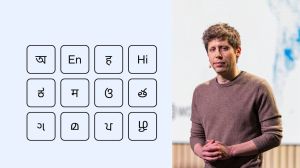BITING THE BALLOT
WHILE THE SPECTRE OF MID-TERM POLLS MAY HAVE REGRESSED TEMPORARILY, POLITICAL PARTIES ARE NOT PREPARED TO BE SURPRISED SHOULD THE EVENTUALITY ARISE.

On Friday morning, there were two pronouncements that indicated a cooling in the political temperature of the country. Both Prime Minister Manmohan Singh and Congress President Sonia Gandhi said at a conference in Delhi that the Government would complete its full tenure and general elections would not be held until 2009.
Yet, the reassurance has not altogether ended speculations about the possibility of mid-term general elections. It all started on August 18, when the Congress gathered its partners in the United Progressive Alliance (UPA), following differences with its Left allies over the Indo-US nuclear agreement and PM’s open challenge to the Left that if they wanted to withdraw support, “so be it.”
The Congress pitched for support of its allies first before it began the hard bargain with the Left. Party managers explained to regional partners that the Left threat was hollow as they were not prepared to face an election at the moment; that even if the Left withdrew support to the UPA Government, they would not vote alongside the BJP to oust the Government. Once assured of the survival of the Government, ministers like Lalu Prasad Yadav and Ram Vilas Paswan turned votaries of the nuclear deal. They came out of the meeting and declared their support for the agreement with the US. “The deal was a collective decision of the UPA. We will face the Left threat together,” was the refrain.
But the Left threat appeared real. On October 6, at the Prime Minister’s Iftar dinner, regional leaders moved around somberly; on October 8, CPI(M) General Secretary Prakash Karat met Sonia to convey the decision of his party’s Central Committee that if the deal was operationalised, the Left would withdraw support—and the CPI(M) would treat any formal talks with the IAEA on India-specific safeguards as “operationalisation”. On October 9, in the fourth meeting of the UPA-Left committee formed to iron out differences over the agreement, Lalu assertively argued for avoiding early elections.
The final word on the deal and the UPA’s longevity has not been said yet. “Everyone wants to avoid an election,” said a member of the Congress core group on the eve of the last meeting with the Left. “But it will take a miracle to avoid an election. The situation today is that an election will take place despite nobody wanting it.”
And while Friday’s assertions of the PM and Sonia may dampen the talk about mid-term polls, no party wants to be caught on the wrong foot. Some UPA partners are already in election mode and most others are scrambling to put their strategies in place.
CONGRESS
On the question of pushing for an mid-term election, there are obviously two opinions within the party. While one section sees this as a time to consolidate its gains with a higher representation in Parliament, most Lok Sabha MPs do not want to go to the hustings just yet. But the Congress can only choose from available political possibilities.
*The party capitulates on the nuclear deal and the Left happily continues with its support. But it will have to consider the flipside: will giving up the deal ensure the survival of the Government till its full term? There is no guarantee of support, especially after Comrade Prakash Karat and the Leftists know they can dictate terms.
*Party pushes ahead with the deal, the Left demurs and the Government falls.
The Congress leadership is trying out a third option that is both delicate and unpredictable. It is to sacrifice the Government if the deal can be saved. The current tight-rope walk of the UPA is to find that narrow path.
The decisionmakers in the party are not averse to an election, but are concerned about reassuring its partners. The Congress wants the responsibility of a mid-term election to fall entirely on the Left. And the Congress also wants the fall of the Government, it it happens, to take place ideally in March 2008. The Grand Old Party is positive about polls on several counts.
*In Madhya Pradesh, Rajasthan and Orissa, the Congress has four, four and two seats respectively. This tally can only go up and the party hopes, substantially so. In Andhra Pradesh and Maharashtra the party hopes to hold on to what it has. In Kerala, the party has no seats, and it will gain at the expense of the Left.
*No UPA partner can look at the BJP as a potential ally in any coming election. The RJD, NCP and DMK will have no option but to stay with the Congress. Paswan is holding out the threat of contesting all 40 seats in Bihar on his own, but this appears more to be aimed at gaining an early bargaining advantage.
*The Congress feels it is at a five-year peak. It can face the electorate before anti-incumbency sets in, projecting Manmohan Singh as PM, and increase its tally from the current 150. The party also calculates that its allies will return with reduced clout. For instance, the RJD may not have the 24 MPs it today has. The party’s aam aadmi schemes will aid its progress, while the fresh air about Rahul Gandhi will energise the organisation.
But there is the other side of the story as well. The party is on the back foot over the Ram Sethu, while the untamable rise in prices of essential commodities has it worried.
THE LEFT
The BJP’s rout in Uttar Pradesh in the assembly elections earlier this year started the countdown for the Left’s split with the Congress—it could be delayed, but difficult to avoid, given that on most fundamental issues of governance, the Left and the Congress do not agree. But both the formations also acknowledge that they may have to come together again, and would, therefore, want to make the split as less bitter as possible.
When the CPI(M) started its showdown with the Congress on the nuclear issue, an influential section within the party, such as West Bengal Chief Minister Buddhadeb Bhattacharjee, argued that an election had to be avoided at all cost. Several Bengal leaders said a friendly government in Delhi was helping the state’s progress. That view gradually lost steam and was rejected at the recent Central Committee meeting in Kolkata. Now a majority of the party feels that irrespective of the losses it could suffer in an election, it cannot be complicit in the nuclear deal.
However, the party will consider it a victory if it manages to stall the nuke agreement and go along with the UPA for the time being, predictably and demonstratively expanding its veto power to newer areas.
What is the CPI(M) calculus?
*Electoral losses are inevitable. “If elections are held in 2009, then too we will lose substantially from our current strength. Therefore, the timing cannot influence the decision we take now,” a party insider said.
*The party assessment is that the BJP is at its lowest at the moment. The threat of a “communal” government coming to power is minimal and the Left can afford some experimentation at present.
*The CPI(M) is in touch with most regional parties, except the BSP and the AIADMK. The party feels the strength of this assorted grouping will go up and the Left will play the cementing role among them. The party interprets, for instance, the TDP’s policy amendments as a step towards a “programmatic third alternative”.
Nuclear deal or not, the Left was anyway preparing grounds for a pull-out. The party’s next Congress is scheduled for March in Coimbatore, and the party cadres in Kerala and West Bengal who grew up on anti-Congress, anti-American rhetoric are getting restive. The Indo-US nuclear agreement gave the Marxists an emotive issue. The party would ideally like an election in mid-2008. So even if this current crisis blows over, the next one will not be far away.
THE BJP
The saffron party is watching from the sidelines, completely incapable of playing any role in influencing the course of events. The BJP’s alliances are in tatters—the party is in yet another phase of “untouchability” vis-à-vis regional parties. In West Bengal, the Trinamool Congress finds the BJP a liability as does the TDP in Andhra Pradesh. In Karnataka, the jolt that the party got from its ally, the JD(S), has set back its southern ambitions. The JD(U) in Bihar is tolerating the saffron party for lack of options. A possible arrangement of some sorts with the AIADMK in Tamil Nadu is the only solace for the Hindutva brigade this season.
However, the BJP will face anti-incumbency in the states it is ruling: Madhya Pradesh, Rajasthan, Chhattisgarh and Gujarat.
The party is pinning its hopes on a subtle Hindu consolidation in its favour and is trying to build up a campaign around issues such as terrorism, the Sachar Committee and the Ram Sethu. The flipside is that this will only make NDA allies more nervous. For instance, Bihar Chief Minister Nitish Kumar does not want to associate with anything remotely Hindutva.
The BJP’s disadvantage is also the lack of sharp leadership and clarity of purpose. The complete mess that the party landed up in over the nuclear debate was illustrative. The leadership question in the BJP remains open-ended, pulling the party in different directions and spreading confusion among the cadre. The party is unable to derive benefits out of the serious differences in the UPA. The party’s relations with the RSS may have improved in recent months, but the undefined nature of it leaves a lot of scope for internal intrigues and manoeuvrings.
THE BSP
The BSP is itching to spread its wings and test its worth outside Uttar Pradesh. The Brahmin mascot of the party, SC Mishra, is sprinting from Gujarat to Maharashtra to Himachal Pradesh to Madhya Pradesh. “We are getting tremendous response from Brahmins and Dalits. Mayawatiji will campaign big time in Himachal and Gujarat,” says Mishra. In Maharashtra, Madhya Pradesh, Haryana and Chhattisgarh, the party scored between 3 and 5 per cent votes in 2004. In Punjab and Uttarakhand, it tallied more than 7 per cent. If it manages to improve its performance after its new all-embracing avatar, the calculations of the Congress gaining seats could be affected.
OTHER REGIONAL PARTIES
Individual MPs of regional parties—who are not participants in the present system—are not keen to face elections, but the satraps are. Each one of them, from Mulayam Singh Yadav and Chandrababu Naidu to H D Deve Gowda and Jayalalitha, believes a more chaotic Parliament will enhance their relevance. And each one secretly hopes, in the melee, to become the prime minister.



- 01
- 02
- 03
- 04
- 05




























